[1] MORAN A, GU D, ZHAO D, et al. Future cardiovascular disease in china: markov model and risk factor scenario projections from the coronary heart disease policy model-china.Circ Cardiovasc Qual Outcomes. 2010;3(3):243-252.
[2] Gude NA, Broughton KM, Firouzi F, et al. Cardiac ageing: extrinsic and intrinsic factors in cellular renewal and senescence. Nat Rev Cardiol. 2018;15(9):523-542.
[3] Costantino S, Paneni F, Cosentino F. Ageing, metabolism and cardiovascular disease. J Physiol. 2016;594(8):2061-2073.
[4] Liao PH, Hsieh DJ, Kuo CH, et al. Moderate exercise training attenuates aging-induced cardiac inflammation, hypertrophy and fibrosis injuries of rat hearts. Oncotarget. 2015;6(34):35383-35394.
[5] Shen T, Liu X, Zhuang B, et al. Efficacy and Safety of Different Aerobic Exercise Intensities in Patients With Heart Failure With Reduced Ejection Fraction: Design of a Multicenter Randomized Controlled Trial (HF-EI Trial). Front Cardiovasc Med. 2021;8:705972.
[6] Guo M, Lu B, Gan J, et al. Apoptosis detection: a purpose-dependent approach selection. Cell Cycle. 2021;20(11):1033-1040.
[7] Liu Y, Xue N, Zhang B, et al. Role of Thioredoxin-1 and its inducers in human health and diseases. Eur J Pharmacol. 2022;919:174756.
[8] Murata R, Watanabe H, Nosaki H, et al. Long-Acting Thioredoxin Ameliorates Doxorubicin-Induced Cardiomyopathy via Its Anti-Oxidative and Anti-Inflammatory Action. Pharmaceutics. 2022;14(3):562.
[9] 张丽红,李海涛,马建林,等.血清Trx1、FGL2与急性心肌梗死后心力衰竭患者预后的关系[J].现代生物医学进展,2023,23(11): 2102-2107.
[10] Kaplán P, Tatarková Z, Lichardusová L, et al. Age-Associated Changes in Antioxidants and Redox Proteins of Rat Heart. Physiol Res. 2019;68(6):883-892.
[11] BEDFORD TG, TIPTON CM, WILSON NC, et al. Maximum oxygen consumption of rats and its changes with various experimental procedures. J Appl Physiol Respir Environ Exerc Physiol. 1979;47(6):1278-1283.
[12] 刘文锋,刘少鹏,傅让,等. 耐力运动对增龄大鼠脑皮层突触可塑性的影响及相关调控机制[J].中国应用生理学杂志,2019,35(4): 339-345,350.
[13] 刘吉焕,王鹏,袁顺灵,等.有氧耐力运动调控大鼠心肌细胞自噬的机制[J].中国组织工程研究,2023,27(23):3714-3720.
[14] LI W, LIU F. Myocardial Cell Aging in the Elderly. Aging Pathobiol Ther. 2020; 2(3):134-142.
[15] Eng J, McClelland RL, Gomes AS, et al. Adverse Left Ventricular Remodeling and Age Assessed with Cardiac MR Imaging: The Multi-Ethnic Study of Atherosclerosis. Radiology. 2016;278(3):714-722.
[16] Frangogiannis NG. Cardiac fibrosis: Cell biological mechanisms, molecular pathways and therapeutic opportunities. Mol Aspects Med. 2019;65:70-99.
[17] Beliveau P, Cheriet F, Anderson SA, et al. Quantitative assessment of myocardial fibrosis in an age-related rat model by ex vivo late gadolinium enhancement magnetic resonance imaging with histopathological correlation. Comput Biol Med. 2015;65:103-113.
[18] Lefferts WK, Davis MM, Valentine RJ. Exercise as an Aging Mimetic: A New Perspective on the Mechanisms Behind Exercise as Preventive Medicine Against Age-Related Chronic Disease. Front Physiol. 2022;13:866792.
[19] Darband SG, Sadighparvar S, Yousefi B, et al. Combination of exercise training and L-arginine reverses aging process through suppression of oxidative stress, inflammation, and apoptosis in the rat heart. Pflugers Arch. 2020;472(2):169-178.
[20] Fatahi A, Zarrinkalam E, Azizbeigi K, et al. Cardioprotective effects of exercise preconditioning on ischemia-reperfusion injury and ventricular ectopy in young and senescent rats. Exp Gerontol. 2022;162:111758.
[21] 李欣,丁树哲,卢健.耐力训练对衰老小鼠心肌Akt/mTOR信号通路的影响[J].中国运动医学杂志,2010,29(1): 38-41.
[22] SAVITSKAYA MA, ONISHCHENKO GE. Mechanisms of Apoptosis. Biochemistry (Mosc). 2015;80(11):1393-1405.
[23] Moldoveanu T, Follis AV, Kriwacki RW, et al. Many players in BCL-2 family affairs. Trends Biochem Sci. 2014;39(3):101-111.
[24] Ludwig LM, Maxcy KL, LaBelle JL. Flow Cytometry-Based Detection and Analysis of BCL-2 Family Proteins 4and Mitochondrial Outer Membrane Permeabilization (MOMP). Methods Mol Biol. 2019; 1877:77-91.
[25] Pereira RM, Mekary RA, da Cruz Rodrigues KC, et al. Protective molecular mechanisms of clusterin against apoptosis in cardiomyocytes. Heart Fail Rev. 2018;23(1):123-129.
[26] DeBalsi KL, Hoff KE, Copeland WC. Role of the mitochondrial DNA replication machinery in mitochondrial DNA mutagenesis, aging and age-related diseases. Ageing Res Rev. 2017;33:89-104.
[27] Czabotar PE, Lessene G, Strasser A, et al. Control of apoptosis by the BCL-2 protein family: implications for physiology and therapy. Nat Rev Mol Cell Biol. 2014;15(1):49-63.
[28] No MH, Heo JW, Yoo SZ, et al. Effects of aging and exercise training on mitochondrial function and apoptosis in the rat heart. Pflugers Arch. 2020;472(2):179-193.
[29] Kwak HB, Song W, Lawler JM. Exercise training attenuates age-induced elevation in Bax/Bcl-2 ratio, apoptosis, and remodeling in the rat heart. FASEB J. 2006;20(6):791-793.
[30] Pei Z, Yang C, Guo Y, et al. Effect of different exercise training intensities on age-related cardiac damage in male mice. Aging (Albany NY). 2021;13(17):21700-21711.
[31] Kwak HB, Lee Y, Kim JH, et al. MnSOD overexpression reduces fibrosis and pro-apoptotic signaling in the aging mouse heart. J Gerontol A Biol Sci Med Sci. 2015;70(5):533-544.
[32] Lu J, Holmgren A. Thioredoxin system in cell death progression. Antioxid Redox Signal. 2012;17(12):1738-1747.
[33] Bjørklund G, Zou L, Peana M, et al. The Role of the Thioredoxin System in Brain Diseases. Antioxidants (Basel). 2022;11(11):2161.
[34] McCarver AC, Lessner DJ. Molecular characterization of the thioredoxin system from Methanosarcina acetivorans. FEBS J. 2014;281(20):4598-4611.
[35] Yu Y, Xing K, Badamas R, et al. Overexpression of thioredoxin-binding protein 2 increases oxidation sensitivity and apoptosis in human lens epithelial cells. Free Radic Biol Med. 2013;57:92-104.
[36] 黄云霞,时杜娟,蒙玉娜,等.弥漫大B细胞淋巴瘤中Trx、TrxR-1及TXNIP的表达及临床意义[J]. 临床与实验病理学杂志,2022,38(4): 443-447.
[37] Mitchell DA, Morton SU, Fernhoff NB, et al. Thioredoxin is required for S-nitrosation of procaspase-3 and the inhibition of apoptosis in Jurkat cells. Proc Natl Acad Sci U S A. 2007;104(28):11609-11614.
[38] Mitchell DA, Marletta MA. Thioredoxin catalyzes the S-nitrosation of the caspase-3 active site cysteine. Nat Chem Biol. 2005;1(3):154-158.
[39] Mahmood DF, Abderrazak A, El Hadri K, et al. The thioredoxin system as a therapeutic target in human health and disease. Antioxid Redox Signal. 2013;19(11):1266-1303.
[40] Pérez VI, Lew CM, Cortez LA, et al. Thioredoxin 2 haploinsufficiency in mice results in impaired mitochondrial function and increased oxidative stress. Free Radic Biol Med. 2008;44(5):882-892.
[41] Li Y, Xu P, Wang Y, et al. Different Intensity Exercise Preconditions Affect Cardiac Function of Exhausted Rats through Regulating TXNIP/TRX/NF-ĸBp65/NLRP3 Inflammatory Pathways. Evid Based Complement Alternat Med. 2020;2020:5809298.
[42] Marschner RA, Banda P, Wajner SM, et al. Short-term exercise training improves cardiac function associated to a better antioxidant response and lower type 3 iodothyronine deiodinase activity after myocardial infarction. PLoS One. 2019;14(9):e0222334.
[43] 黄海高,李悦山.Trx-ASK1在多柔比星诱导的乳鼠心肌细胞凋亡中的作用[J].中国病理生理杂志,2012,28(6):1028-1033.
[44] 赵晓琴,赵俊杰,李晓宇,等.2型糖尿病大鼠心肌损伤时心肌组织中硫氧还蛋白系统的变化[J]. 生理学报,2010,62(3): 261-268.
[45] Liu Q, Sargent MA, York AJ, et al. ASK1 regulates cardiomyocyte death but not hypertrophy in transgenic mice. Circ Res. 2009;105(11): 1110-1117.
|
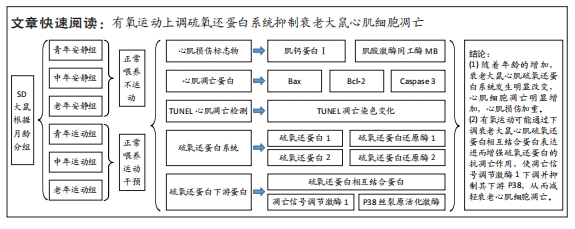
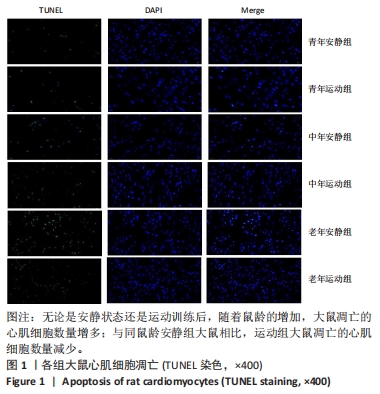
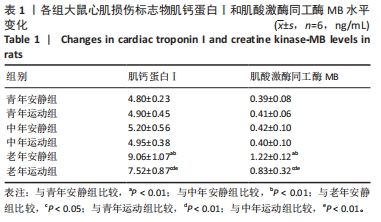
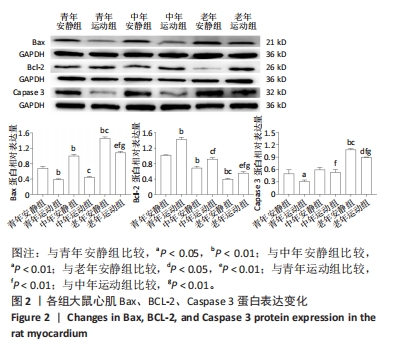
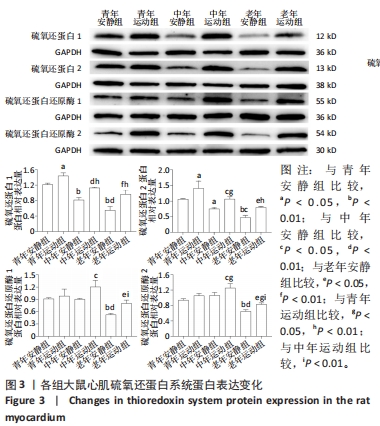
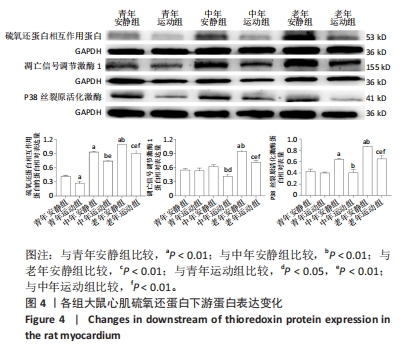

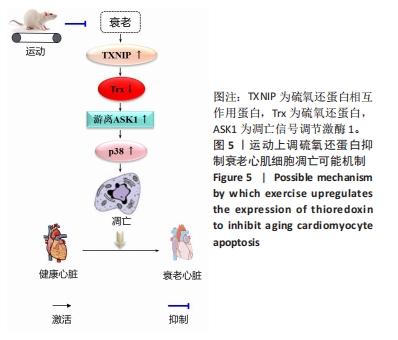 结论:随着年龄的增加,衰老大鼠心肌硫氧还蛋白系统发生明显改变,心肌细胞凋亡明显增加,心肌损伤加重,有氧运动可能通过下调心肌硫氧还蛋白相互作用蛋白表达进而增强硫氧还蛋白的抗凋亡作用,下调凋亡信号调节激酶1抑制其下游P38丝裂原活化激酶丝裂原活化激酶,从而减轻衰老大鼠心肌细胞的凋亡。
结论:随着年龄的增加,衰老大鼠心肌硫氧还蛋白系统发生明显改变,心肌细胞凋亡明显增加,心肌损伤加重,有氧运动可能通过下调心肌硫氧还蛋白相互作用蛋白表达进而增强硫氧还蛋白的抗凋亡作用,下调凋亡信号调节激酶1抑制其下游P38丝裂原活化激酶丝裂原活化激酶,从而减轻衰老大鼠心肌细胞的凋亡。